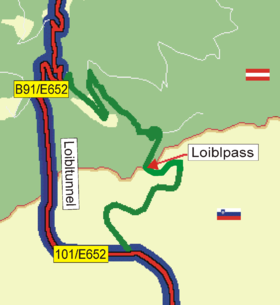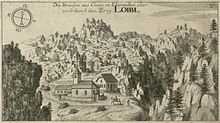Loibl Pass
This article includes a list of references, related reading, or external links, but its sources remain unclear because it lacks inline citations. (January 2013) |
| Loibl Pass | |
|---|---|
 Map showing the location of the historic pass road | |
| Elevation | 1,367 m (4,485 ft) |
| Traversed by | road |
| Location | |
| Range | Alps |
The Loibl Pass (Template:Lang-de) or Ljubelj Pass (Template:Lang-sl) is a high mountain pass in the Karavanke chain of the Southern Limestone Alps, linking Austria with Slovenia. The century-old pass near the Stol summit is the shortest connection between the Carinthian town of Ferlach and Tržič in Upper Carniola.

Different trails were used since ancient times, connecting Virunum in the Roman province of Noricum with Emona (at present-day Ljubljana). The strategic importance of the Loibl increased again after the establishment of the Imperial March of Carniola in the 11th century, the ruling Patriarchs of Aquileia entrusted the maintenance to the monks of Viktring Abbey, who rivaled with claims raised by the local Lords of Hollenburg (Humberk) Castle.
From about 1560 the estates of the Carinthian duchy had the road extended. A 150 m (500 ft) long tunnel was built underneath the Karavanke chine, an early example of modern engineering that later had to be abandoned due to lack of safety. Another attempt was planned in the 17th century, as the road across the Loibl had become an important trade route between the Carinthian capital of Klagenfurt and the seaport of Trieste. However, when in 1728 Emperor Charles VI toured the lands of the Habsburg Monarchy he still had to travel over the summit, stopping by the Deutscher Peter tavern and ordering some road work.
During World War II, a 1,570 m (5,150 ft) meter long tunnel was built at 1,068 m (3,504 ft) above sea level by the command of Nazi Gauleiter Friedrich Rainer, carried out by 660 civil workers, several posted by the French Service du travail obligatoire, and 1652 prisoners of two minor sub-camps of the Mauthausen-Gusen concentration camp on both sides under the notorious SS commandant Julius Ludolf. Construction started in 1943; to keep the work force effective, injured or sick prisoners were sent back to the main camp, or executed by camp physician Sigbert Ramsauer by the injection of petrol if not able to be transported. As the surviving 950 prisoners could free themselves on 7 May 1945, these were the only sub-camps of Mauthausen-Gusen not to be either evacuated or liberated until the end of the war. Today a memorial marks the site of the southern Loibl camp.

The first army vehicles passed the very tight tunnel on 4 December 1944. Military traffic, Wehrmacht soldiers retreating from the Yugoslav Front and refugees used the tunnel until it was closed in 1947. Then a border crossing between Austria and the Federal People's Republic of Yugoslavia, it was reopened in 1950 and expanded to two lanes in 1966, while the old road over the mountain pass itself has been closed for traffic since 1967.
The importance of the Loibl Pass has diminuished since 1991, when the 7,864 m (25,801 ft) long Karawanken Motorway Tunnel, which connects the Austrian Karawanken Autobahn (A 11) from Villach with the Slovenian A2 motorway to Ljubljana. Border controls have been abolished with Slovenia joining the Schengen Area effective from 21 December 2007.
See also
External links
 Media related to Loibl Pass at Wikimedia Commons
Media related to Loibl Pass at Wikimedia Commons- Profile on climbbybike.com

